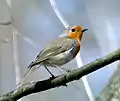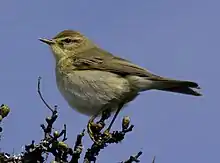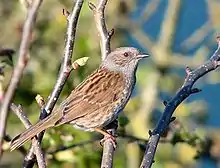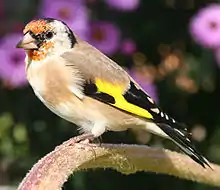Dawn chorus (birds)
The dawn chorus occurs when birds sing at the start of a new day. In temperate countries this is most noticeable in spring when the birds are either defending a breeding territory, trying to attract a mate, or calling in the flock. In a given location, it is common for different species to do their dawn singing at different times. In a study of the Ecuadorian forest, it was determined that birds perching higher in the trees and birds with larger eyes tend to pipe up first.[1] These correlations may be caused by the fact that both would also correlate with the amount of light perceived by the bird.[1]
Moller used a play-back technique to investigate the effects of singing by the black wheatear (Oenanthe leucura) on the behaviour of both conspecifics and heterospecifics. It was found that singing increased in both groups in response to the wheatear. Moller suggested the dawn (and dusk) chorus of bird song may be augmented by social facilitation due to the singing of conspecifics as well as heterospecifics.[2]
In some territories where bird life is extensive and birds are vocal, the sound of a dawn chorus can render early morning sleeping difficult.[3][4][5]
International Dawn Chorus Day
An annual International Dawn Chorus Day is held on the first Sunday in May[6] where the public are encouraged to rise early to listen to bird song, at organised events. The first ever was held at Moseley Bog in Birmingham, England in 1984, by the Urban Wildlife Trust (now The Wildlife Trust for Birmingham and the Black Country).
New Zealand
Early explorers and European settlers noted that the New Zealand forest had a loud dawn chorus. This is no longer the case due to extensive loss of forests and the introduction of bird predators and competing species such as wasps. The bellbird and the tui are two of the birds that would have formed part of the dawn chorus since they have a vocal and melodious call.
United Kingdom
In the UK the dawn chorus may begin as early as 3am in early summer. The most often heard species of birds are, in order of their beginning to sing:
- Blackbird
- Robin
- Eurasian wren
- Tawny owl
- Chaffinch
- Common pheasant
- Warblers, including blackcap, chiffchaff, garden warbler and willow warbler
- Song thrush
- Greenfinch
- Dunnock
- Goldfinch





_male_2.jpg.webp)
 Blackcap
Blackcap.jpg.webp)





In non-avian species
Several primate species vocalise early in the morning as an audible territorial display. These include the lesula (Cercopithecus lomamiensis), the black howler (Alouatta caraya) (which can be heard 5 km away), mantled guereza (Colobus guereza) and the gibbon (Hylobatidae).[7]
References
- Jamieson, Barrie Gillean Molyneux (editor) (2007) Reproductive Biology and Phylogeny of Birds: Sexual selection, behavior, conservation, embryology, genetics (Part B of Reproductive Biology and Phylogeny of Birds) Science Publishers, Enfield, New Hampshire, page 183, ISBN 978-1-57808-386-2
- Moller, A.P., (1992). Interspecific response to playback of bird song. Ethology, 90: 315-320. DOI: 10.1111/j.1439-0310.1992.tb00842.x
- Carson, Rachel and Freeman, Dorothy (1995) Always, Rachel: the letters of Rachel Carson and Dorothy Freeman, 1952-1964 Beacon Press, Boston, Massachusetts, page 462, ISBN 0-8070-7010-6
- Gregg, Emma and Trillo, Richard (2003) Rough guide to the Gambia Rough Guides, New York, page 220, ISBN 1-84353-083-X
- Lowman, Margaret; Burgess, Edward and Burgess, James (2006) It's a jungle up there: more tales from the treetops Yale University Press, New Haven, Connecticut, page 168, ISBN 0-300-10863-X
- IDCD.info
- Schel, A.M.; Zuberbühler, K. (2011). "Dawn chorusing in guereza colobus monkeys". Behavioral Ecology and Sociobiology. 66 (3): 361. doi:10.1007/s00265-011-1282-3. S2CID 7149453.